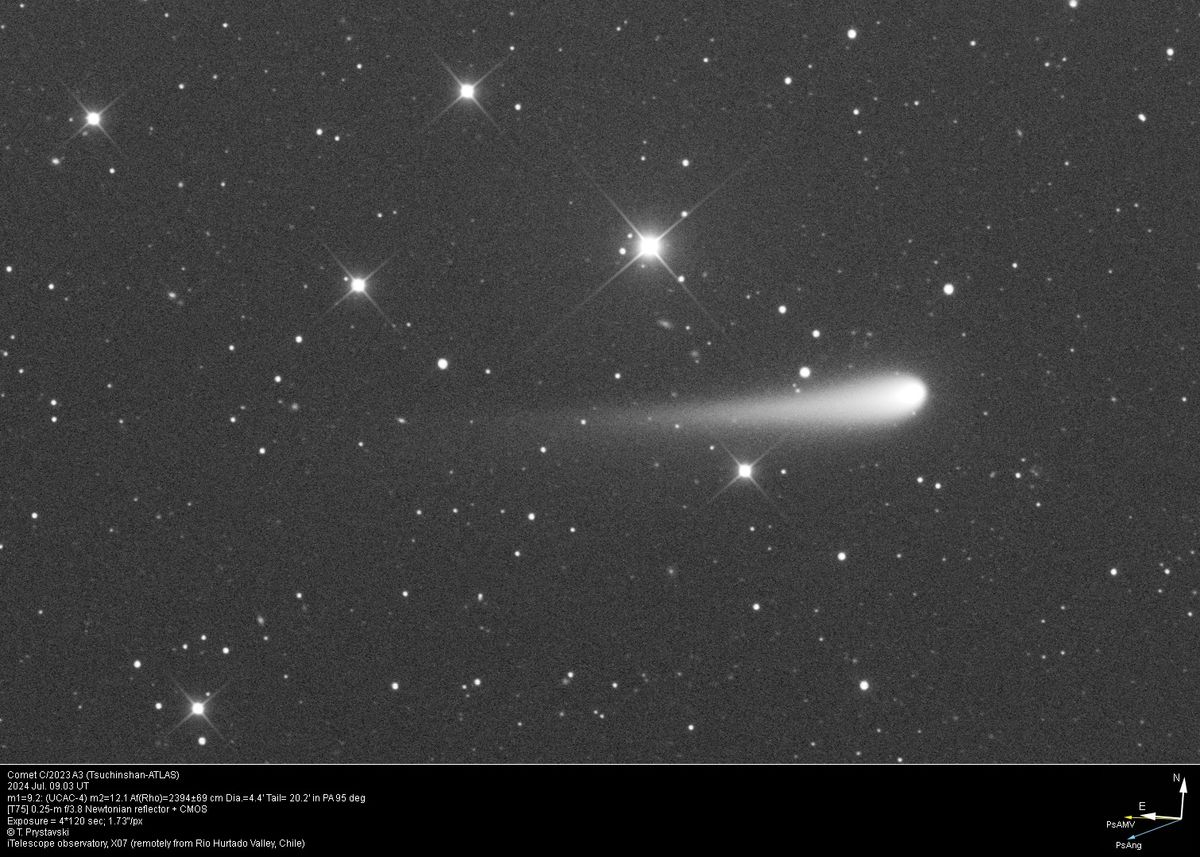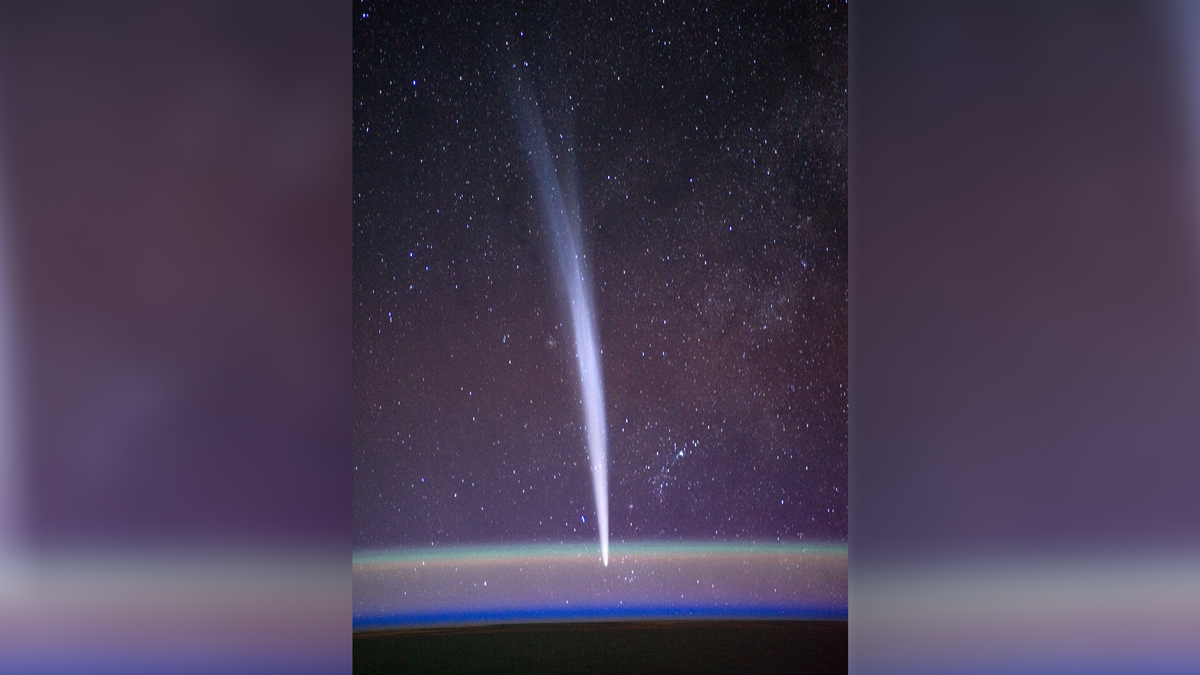In recent months there has been a gradual increase in excitement about the approach of a new comet named Tsuchinshan-ATLAS, officially cataloged as C/2023 A3.
Comet Tsuchinchan-ATLAS (C/2023 A3) was first detected at XuYi Station of the Purple Mountain Observatory in China on January 9, 2023, then lost and was re-detected 44 days later by the Early Warning System of The End of Earth Impact Asteroid (ATLAS) research project station in Sutherland, South Africa. Hopes have been running up that this would become a bright object to the naked eye by the fall of 2024.
But a new technical document recently released on July 9, by a well-known comet expert, says that Comet Tsuchinshan-ATLAS, instead of dazzling, will in all likelihood break up and disintegrate before it has a chance to orbited the sun at the end of September.
The report comes from Dr. Zdeněk Sekanina, formerly at NASA/JPL, and an expert on comet breakup and breakup. In his report, Dr. Sekanina gives three main reasons he believes the comet is finished:
“The purpose of this paper,” writes Dr. Sekanina, “is not to disappoint comet watchers who have been eagerly awaiting a new naked-eye object next October, but to present scientific arguments that do not seem to bear out such hopes.” While openly admitting that predicting the disintegration of a comet before it reaches its closest point to the sun (perihelion) is “undoubtedly a very dangerous undertaking,” Dr. Sekinina thinks “it’s time to get on with it.”
Comet Tsuchinshan-ATLAS is predicted to reach perihelion on September 27, at a distance of 36 million miles (58 million km) from the sun – a distance equal to that of the average distance of Mercury, the closest planet to our star.
If you want to see Comet Tsuchinshan–ATLAS this year (if it remains intact!), our guides to the best telescopes and best binoculars are a great place to start. And if you’re looking to take stellar pictures of the night sky, check out our guides on how to photograph comets, or our recommendations for the best astrophotography cameras and the best astrophotography lenses.
Who do we trust?
Because Dr. Sekanina is highly respected in the field, whatever he says carries a lot of weight in astronomical circles. However, his thoughts regarding the future of the approaching comet have been met with faith and conviction mixed with skepticism and uncertainty.
A person who had high hopes for a big show from Tsuchinshan-ATLAS, but now seems to have changed his mind based on the conclusion of Dr. Sekanina is Joseph Marcus, a pathologist with a long-standing interest in comets. As a resident at Washington University in St.
“The case that Sekanina makes is compelling. In the unlikely event that C/2023 A3 survived perihelion, it would see a brightness increase of nearly 7 magnitudes.” (equal to a brightness enhancement ratio of nearly 600-fold). “But,” he adds, “it is now a moot point. I am betting on disintegration, as Sekanina now advocates, and to which I unreservedly defer. After all, the comet will soon be no more.”
But others aren’t convinced yet…
Nick James, director of the British Astronomical Society’s Comet Section, says that while Sekanina’s paper is “fascinating”, he finds no evidence of non-gravitational accelerations. “That doesn’t look like a comet breaking up to me,” he says.
Another skeptic is Dr. Clay Sherrod of the Arkansas Sky Observatories at Mount Petit Jean. “Comet isn’t going anywhere; it’s just good and not ‘fragmenting’ in my opinion,” he notes.
Look “healthy”
Echoing Dr. Sherrod and Mr. James, it is Taras Prystavski, an amateur astronomer living in Lviv, Ukraine, who enjoys photographing a variety of celestial objects such as comets. He provided Space.com with an image of Tsuchinshan-ATLAS taken on July 9, commenting that: “To me, the comet looks healthy. Some images show that an ion tail has also appeared, but very faint. I know a view of the ion tail shows that the comet’s nucleus is healthy. So there is a small hope of seeing a great display in the fall.”

Finally, there’s Daniel Green at the Central Bureau of Electronic Telegrams (CBET), who carefully writes: “I think the comet looks healthy and is now showing an ion tail as well. I see no evidence that this comet is disintegrating, so that all we can do now is wait and see until the end of September (if not a little earlier) if it will be a clean comet in October.
Predicting the future is difficult!
The late baseball great Yogi Berra once said, “It’s hard to make predictions, especially about the future.” These words certainly ring true when trying to predict what a young comet might do.
While it is true that the brightness of Comet Tsuchinshan-ATLAS is more or less flat from mid-April to late June at magnitude +10.5, there are signs that its brightness is (based on Comet Observation Database/COBS) slowly starts to grow again during the first half of July.
Telescopes reveal that the comet’s dusty head or coma has swelled to a linear diameter of approximately 180,000 miles (290,000 km), while its tail is now approximately 1 million miles (1.6 million km) in length. Unfortunately for viewers in the northern hemisphere, the comet is now getting too close to the sun’s brightness to observe; in the coming weeks only those living south of the equator will be able to observe its future progress.
Currently, the comet is approximately 158 million miles (254 million km) from the sun and is experiencing temperatures around -150°F (-100°C). It has now begun to cross the “water line” where the frozen gases sublimate into steam. If it survives to perihelion on September 27 (something Dr. Sekanina does not expect to happen) it will be subjected to temperatures exceeding 1,600°C.
The hot tea analogy
Now imagine this: Here we have a chunk of matter that likely dates back to the very beginning of the solar system, nearly 5 billion years ago, which during that entire time has been locked in an incredibly cold environment with temperatures that move close to absolute zero. However, in the coming weeks, it will encounter increasingly hot temperatures of hundreds of degrees.
So what happens when you pour hot tea into a cold glass?
This is what may happen to Comet Tsuchinshan-ATLAS in the coming weeks; it can shatter and collapse completely.
Not a foregone conclusion
Does this mean, as Dr. Sekanina titled his paper, that it is one “The Inevitable End” for Comet Tsuchinshan-ATLAS?
Not necessarily.
In November 2011, Australian amateur astronomer Terry Lovejoy discovered a very small comet whose nucleus was only 1,600 feet (500 meters) in diameter and was about to pass. only 87,000 miles (140,000 km) from the surface of the sun. It was not expected to survive and yet somehow it did and briefly gave a very visually beautiful show for Southern Hemisphere observers (some time later, after rounding the sun, Comet Lovejoy did indeed disintegrate as it returned to space).

And in 1996, a comet that was promoted as a “can’t miss” spectacular was heading toward the sun and then suddenly and inexplicably stopped shining all the way from the first week of July to mid-October. Then suddenly, the comet got back on track and began to shine, but then just as quickly its brightness faded again by mid-November. Some were very worried that the Comet would become a failure. But in the spring of 1997, all fears were put to rest as the comet put on a beautiful celestial display.
The name of the comet? Hale-Bopp.
So maybe Yogi was right, making predictions about the future IS difficult. And perhaps the only thing we can do now, as Daniel Green suggests, is to take a “wait and see” attitude about what Tsuchinshan-ATLAS will do in the coming days and weeks. It may fall apart, as Dr. Sekanina predicts, but for now it’s still whole and hearty.
And to that end, let me invoke one final yogi-ism:
“It ain’t over, ’til it’s over!”
Joe Rao serves as an instructor and guest lecturer in New York Hayden Planetarium. He writes about astronomy for Journal of Natural History, Farmers’ Almanac and other publications.